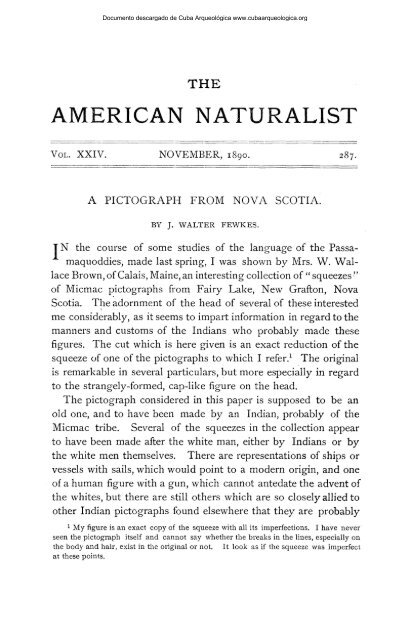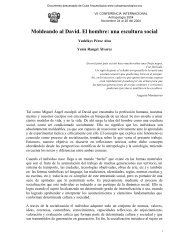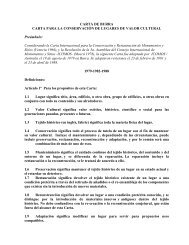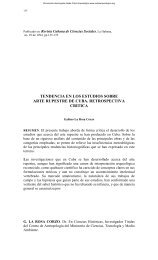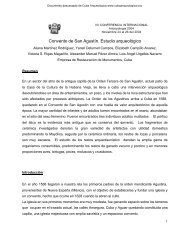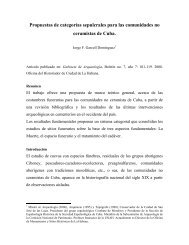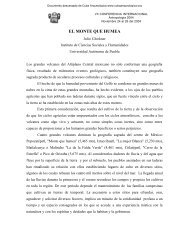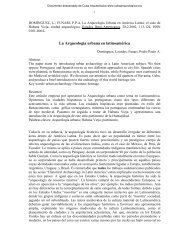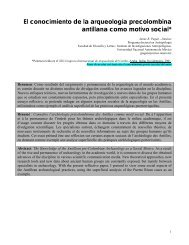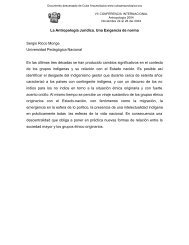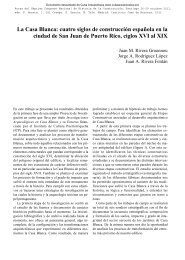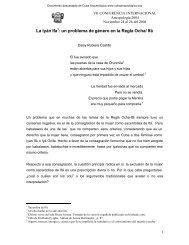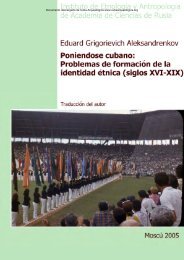A Pictograph from Nova Scotia - Cuba Arqueológica
A Pictograph from Nova Scotia - Cuba Arqueológica
A Pictograph from Nova Scotia - Cuba Arqueológica
Create successful ePaper yourself
Turn your PDF publications into a flip-book with our unique Google optimized e-Paper software.
Documento descargado de <strong>Cuba</strong> <strong>Arqueológica</strong> www.cubaarqueologica.org<br />
THE<br />
AMERICAN NATURALIST<br />
VOL. XXIV. NOVEMBER, 1890. 287.<br />
A PICTOGRAPH FROM NOVA SCOTIA.<br />
BY J. WALTER FEWKES.<br />
JN the course of some studies of the language of the Passamaquoddies,<br />
made last spring, I was shown by Mrs. W. Wallace<br />
Brown, of Calais, Maine, an interesting collection of " squeezes?'<br />
of Micmac pictographs <strong>from</strong> Fairy Lake, New Grafton, <strong>Nova</strong><br />
<strong>Scotia</strong>. The adornment of the head of several of these interested<br />
me considerably, as it seems to impart information in regard to the<br />
manners and customs of the Indians who probably made these<br />
figures. The cut which is here given is an exact reduction of the<br />
squeeze of one of the pictographs to which I refer.' The original<br />
is remarkable in several particulars, but more especially in regard<br />
to the strangely-formed, cap-like figure on the head.<br />
The pictograph considered in this paper is supposed to be an<br />
old one, and to have been made by an Indian, probably of the<br />
Micmac tribe. Several of the squeezes in the collection appear<br />
to have been made after the white man, either by Indians or by<br />
the white men themselves. There are representations of ships or<br />
vessels with sails, which would point to a modern origin, and one<br />
of a human figure with a gun, which cannot antedate the advent of<br />
the whites, but there are still others which are so closely allied to<br />
other Indian pictographs found elsewhere that they are probably<br />
1 My figure is an exact copy of the squeeze with all its imperfections. I have never<br />
seen the pictograph itself and cannot say whether the breaks in the lines, especially on<br />
the body and hair, exist in the original or not. It look as if the squeeze was imperfect<br />
at these points.
Documento descargado de <strong>Cuba</strong> <strong>Arqueológica</strong> www.cubaarqueologica.org<br />
996 The American NAatiralisi. [November,<br />
veritable Indian productions. The occurrence of old and new<br />
together is what might be expected. There is an almost involuntary<br />
tendency to add one's name to a wall where others have<br />
placed theirs. Many examples of this might be mentioned; for<br />
instance, Inscription Rock, on the road <strong>from</strong> Acoma to Zuni<br />
Pueblo, New Mexico, bears side by side Indian pictographs, ancient<br />
and modern, and the names and dates of visits of travelers,<br />
<strong>from</strong> the end of the sixteenth to the nineteenth century. The<br />
fact, therefore, that there are some modern pictographs associated<br />
with the one we are considering does not mean that it also is<br />
modern. While the style of the dress might suggest modern<br />
times after association with the whites, the remainder of the<br />
pictograph has an ancient look which is suggestive.<br />
While it must be confessed that the explanation of these headdresses<br />
proposed in the following lines is conjectural, there is evidence<br />
which seems to support it. Evidently these pictographs<br />
represent some costume with which the maker was familiar, and<br />
can hardly be called fanciful. A pictograph of an Indian with a<br />
gun, or a ship with sails, both of which are represented in the<br />
collection, affords inherent evidence of the modern origin of the<br />
pictograph. It would seem, if the same were not true of undoubtedly<br />
ancient pictographs, that the form of the dress of the<br />
figure represented in the cut recalled the skirt of the white<br />
woman, yet the general character of the pictograph indicates its<br />
age, as ancient pictographs with the same form are not unknown.<br />
If an ancient pictograph, the form represented in the head-dress<br />
must have been a familiar one to the graver. Analogy with<br />
other pictographs of known significance, rather than exact<br />
knowledge, would lead me to interpret this as a mask or headdress<br />
worn in the dance or on festal or religious occasions.<br />
I have seen at the Indian settlement at Pleasant Point a headdress<br />
ornamented with feathers, which is kept as a curiosity of the<br />
olden time; and it is known that in olden time our New England<br />
Indians wore such ornaments. Yet I am familiar with but few<br />
representations of pictographs of head-dressed ornamented with<br />
feathers which are as elaborately delineated as those cut on the<br />
rocks of <strong>Nova</strong> <strong>Scotia</strong>, of which a cut is here reproduced.
Documento descargado de <strong>Cuba</strong> <strong>Arqueológica</strong> www.cubaarqueologica.org<br />
i890.] A <strong>Pictograph</strong> <strong>from</strong> Nozva <strong>Scotia</strong>. 997<br />
In trying to discover the meaning of this representation I have<br />
not been able to satisfy myself that its significance has been correctly,<br />
or at least satisfactorily, interpreted. It seems improbable<br />
that it was intended to represent a head-dress such as have been<br />
taken <strong>from</strong> the skulls of Indians which have been exhumed at<br />
MICMAC PICTOGRAPH, WITH PROBLEMATICAL HEAD-DRESS.<br />
certain points on the neighboring coast of Maine. While in form<br />
it distantly resembles the pointed caps which the Micmacs and<br />
Passamaquoddies wore in recent times, it seems but a rude representation<br />
of such, and one which an Indian would hardly have<br />
sketched in the relative form and size represented.
Documento descargado de <strong>Cuba</strong> <strong>Arqueológica</strong> www.cubaarqueologica.org<br />
998 Riie American Naturalist. [November,<br />
The interpretation which has suggested itself is as follows:<br />
The likeness to a dance-mask or dance-tablet is so close that the<br />
possibility of its being a representation of some of the paraphernalia<br />
of the dances occurred to me. Familiar with similar masks<br />
and elaborate tablets borne on the head by the Pueblo Indians at<br />
the present day in several of their ceremonial dances, the likeness<br />
of the appendage represented on the head of the <strong>Nova</strong> <strong>Scotia</strong><br />
pictograph suggested that it might have a similar sacred importance.<br />
It is not uncommon to find dance-masks represented in<br />
the pictographs made by the Indians. The pictographs of<br />
human faces which one finds in such abundance in the neighborhood<br />
of Zufii Pueblo, New Mexico, often representthose personages<br />
who take part in the sacred dances. This is more especially<br />
true where human beings are represented, and it is not rare to<br />
find heads of Ko kas, of Sia'la'kos, and even of the Koyea'maske,<br />
represented so truthfully that they can be readily recognized. It<br />
is not uncommon to find the masks alone of dancers represented,<br />
and it is believed that in all such cases there is a certain religious<br />
significance in the pictograph, and a sacred meaning in such representations.<br />
Such also, it may be surmised, is the meaning of<br />
the figure portrayed in the Micmac pictograph. We may have<br />
here a representation of an old dance-figure wearing on the head<br />
a mask not unlike the masks still carried by the tribes which have<br />
preserved to the present day their ancient religious rites. If this<br />
interpretation of the head-dress of the pictograph <strong>from</strong> <strong>Nova</strong><br />
<strong>Scotia</strong> is a correct one, as seems plausible, it may give us an insight<br />
into the character of the dress of the dancers in ancient<br />
Micmac ceremonials.<br />
I have also seen, in the same collection above referred to,<br />
pointed rectangular pictographs, with one side inclined to the<br />
other, which would also seem to be representations of former<br />
head-dresses for use or ornament. Some of these are represented<br />
elaborately ornamented with cross-lines, as in our figure,<br />
and some are surmounted with feathers, as in the pictograph represented<br />
in the cut. Isolated examples of these are often cut on<br />
the rocks, while their frequency would indicate that they have<br />
a meaning of some kind. We often find in the collection the<br />
same rectangular structure on the heads of human figures, but
Documento descargado de <strong>Cuba</strong> <strong>Arqueológica</strong> www.cubaarqueologica.org<br />
i890.] A Pictograpli form <strong>Nova</strong> <strong>Scotia</strong>. 999<br />
quite as often the head-dresses are represented alone. It seems<br />
hardly probable, if they represent simple caps or hats, that the<br />
Indians would take the trouble to cut them on the rocks in the<br />
elaborate way in which they occur; but if they represent paraphernalia<br />
of the dance one can readily suppose that they would<br />
be thus carefully represented.<br />
Moreover, we find among many tribes that the custom of cutting<br />
pictographs of dance-masks and other head-dresses which<br />
are used in religious ceremonials is a common practice, as any<br />
one who has studied the pictographs in the Southwest may attest.<br />
I would therefore suggest that in the figure represented in the<br />
cut we have a picture of a Micmac wearing a mask possibly<br />
worn in sacred ceremonials.<br />
'The long appendage to the head is interesting. It is supposed<br />
to represent the hair tied up in the ancient fashion. In old times<br />
the Passamaquoddy Indians, more especially the squaws, tied their<br />
hair on a flat plate, sometimes of shell, on the edges of which<br />
were holes through which a string was woven. There is an old<br />
folk-tale of the Passamaquoddies in which a string made of eelskin<br />
was used for this purpose. Possibly we have represented in<br />
the cut a similar method of doing up the hair formerly used by<br />
the Micmacs and Passamaquoddies.<br />
While it is not the purpose of this communication to comment<br />
on, much less discuss, the antiquity of the New Grafton pictographs,<br />
some of which are undoubtedly modern, it must be said<br />
that there are evidences of antiquity in many particulars as far as<br />
many are concerned. Through the kindness of Mrs. Brown, I<br />
have in my possession the squeezes of several of those which<br />
seem to indicate an ancient origin as far as the subject treated is<br />
concerned. It is one object of the present communication to call<br />
attention to the possibility of gathering some information in regard<br />
to the former customs of the ancient aborigines of <strong>Nova</strong><br />
<strong>Scotia</strong>, New Brunswick, and New England <strong>from</strong> the picturewritings<br />
which they have left behind. The locality in which<br />
the pictograph represented in the cut is found is particularly rich in<br />
ancient picture-drawings, and would, I should judge, repay acareful,<br />
systematic exploration and study with this thought in mind


